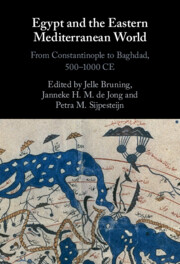Book contents
- Egypt and the Eastern Mediterranean World
- Egypt and the Eastern Mediterranean World
- Copyright page
- Contents
- Figures, Graphs, and Tables
- Notes on Contributors
- Notes on Transliteration, Names, and Dates
- Preface and Acknowledgments
- Additional material
- Introduction
- Part I Political and Administrative Connections
- Part II Economic Connections
- Part III Social and Cultural Connections
- Chapter 10 The Destruction of Alexandria: Religious Imagery and Local Identity in Early Islamic Egypt
- Chapter 11 Scribal Networks, Taxation, and the Role of Coptic in Marwanid Egypt
- Chapter 12 A Changing Position of Greek? Greek Papyri in the Documentary Culture of Early Islamic Egypt
- Chapter 13 Regional Diversity in the Use of Administrative Loanwords in Early Islamic Arabic Documentary Sources (632–800 CE): A Preliminary Survey
- Chapter 14 Babylon/Qaṣr al-Shamʿ: Continuity and Change at the Heart of the New Metropolis of Fusṭāṭ
- Chapter 15 Utilizing Non-Muslim Literary Sources for the Study of Egypt, 500–1000 CE
- Index
- References
Chapter 12 - A Changing Position of Greek? Greek Papyri in the Documentary Culture of Early Islamic Egypt
from Part III - Social and Cultural Connections
Published online by Cambridge University Press: 01 December 2022
- Egypt and the Eastern Mediterranean World
- Egypt and the Eastern Mediterranean World
- Copyright page
- Contents
- Figures, Graphs, and Tables
- Notes on Contributors
- Notes on Transliteration, Names, and Dates
- Preface and Acknowledgments
- Additional material
- Introduction
- Part I Political and Administrative Connections
- Part II Economic Connections
- Part III Social and Cultural Connections
- Chapter 10 The Destruction of Alexandria: Religious Imagery and Local Identity in Early Islamic Egypt
- Chapter 11 Scribal Networks, Taxation, and the Role of Coptic in Marwanid Egypt
- Chapter 12 A Changing Position of Greek? Greek Papyri in the Documentary Culture of Early Islamic Egypt
- Chapter 13 Regional Diversity in the Use of Administrative Loanwords in Early Islamic Arabic Documentary Sources (632–800 CE): A Preliminary Survey
- Chapter 14 Babylon/Qaṣr al-Shamʿ: Continuity and Change at the Heart of the New Metropolis of Fusṭāṭ
- Chapter 15 Utilizing Non-Muslim Literary Sources for the Study of Egypt, 500–1000 CE
- Index
- References
Summary
For more than a millennium (ca. 330 BCE–eighth century CE) the Greek language was an important communicative tool in Egypt, both in written and in spoken form, leaving a firm imprint on Egypt’s documentary landscape. Beyond its communicative capacity, the Greek language in Egypt was important for its symbolic value. This is especially clear in its use in expressing power and social relations. As the language employed by the ruling power, Greek could symbolize the political order, which it did in Egypt under the Ptolemaic, Roman, and Byzantine regimes. Greek can also be considered as an identity marker, which helped to define borders between different social groups. The ability to read and write Greek was strongly connected to one’s social position and the concomitant opportunities for education. The significance of Greek in Egypt under Ptolemaic, Roman, and Byzantine rule is therefore clear.
- Type
- Chapter
- Information
- Egypt and the Eastern Mediterranean WorldFrom Constantinople to Baghdad, 500-1000 CE, pp. 379 - 407Publisher: Cambridge University PressPrint publication year: 2022



